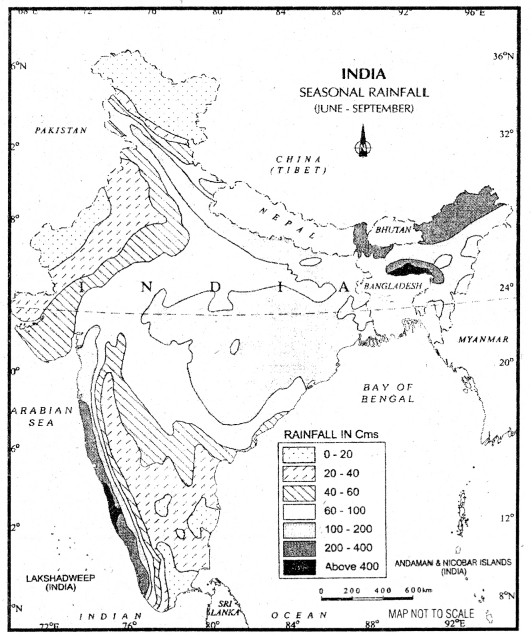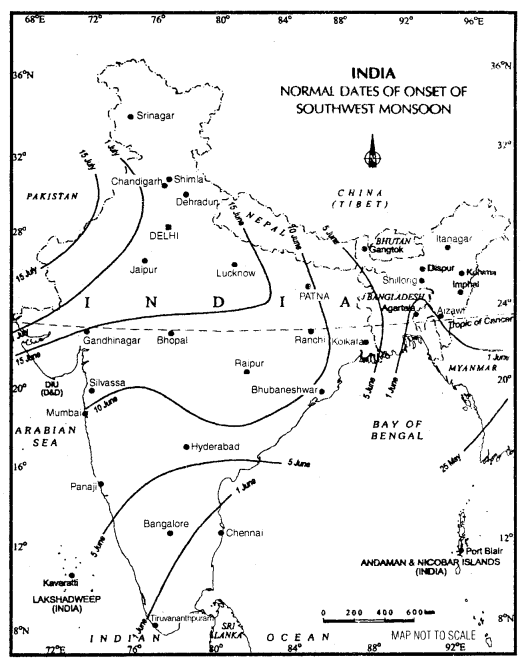NCERT Solutions | Class 11 Geography (India Physical Environment) Chapter 4 | Climate

CBSE Solutions | Geography Class 11
Check the below NCERT Solutions for Class 11 Geography (India Physical Environment) Chapter 4 Climate Pdf free download. NCERT Solutions Class 11 Geography were prepared based on the latest exam pattern. We have Provided Climate Class 11 Geography NCERT Solutions to help students understand the concept very well.
NCERT | Class 11 Geography (India Physical Environment)
| Book: | National Council of Educational Research and Training (NCERT) |
|---|---|
| Board: | Central Board of Secondary Education (CBSE) |
| Class: | 11 |
| Subject: | Geography |
| Chapter: | 4 |
| Chapters Name: | Climate |
| Medium: | English |
Climate | Class 11 Geography | NCERT Books Solutions
Important Questions for Class 11 Geography Chapter 4 Climate
Climate Important Extra Questions Very Short Answer Type
Question 1.
Answer:
Jet streams.Question 2.
Answer:
Thunderstorms.Question 3.
Answer:
Kalbaishakhi.Question 4.
Answer:
125 cm.Question 5.
Answer:
The coldest place in India is Drass(Kargil). Here the temperature drops upto-45°C.Question 6.
Answer:
The Barmer (50°C) is the hottest place in Rajasthan.Question 7.
Answer:
Tamil Nadu, Andhra Pradesh, West Bengal and Orissa.Question 8.
Answer:
North-east monsoon causes winter rainfall in south-east coast.Question 9.
Answer:
Over the Coromandel coast.Question 10.
Answer:
The oppressive weather due to high temperature and high humidity is known as October heat.Question 11.
Answer:
Assam-Bordoi chilla, Bengal – Kalbaishakhi.Question 12.
Answer:
Tropical monsoon type climate.Question 13.
Answer:
Pressure difference and the jet stream.Question 14.
Answer:
- South-west monsoon season.
- North-east monsoon season.
Question 15.
Answer:
In Jammu and Kashmir.Question 16.
Answer:
Heatwave.Question 17.
Answer:
Mawsynram and Cherrapunji.Question 18.
Answer:
Temperature, rainfall.Question 19.
Answer:
The Thomthwaite’s classification is based on the criterion of moisture index.Question 20.
Answer:
- the Arabian Sea,
- The Bay of Bengal.
Question 21.
Answer:
The ITCZ means Inter-Tropical Convergence Zone.Question 22.
Answer:
Tropic of Cancer (23!/2°N latitude).Question 23.
Answer:
The sun shines vertically over the Tropic of Caricom (23 1/2°S).Question 24.
Answer:
At the end of September.Question 25.
Answer:
Koeppen’s classification is based on monthly values of temperature and precipitation.Climate Important Extra Questions Short Answer Type
Question 1.
Answer:
In India the year is divided into four seasons based on Indian meteorology.- The cold weather season – begins from December to February.
- The hot weather season – begins from March to May.
- The south-west monsoon season – begins from June to September.
- Theretreatingmonsoon season-beginsfromOctobertoNovember.
Question 2.
Answer:
The coldest parts of India are the trans-Himalayan regions. Jammu Kashmir and Himachal Pradesh are the coldest states of India. The minimum temperature drops up to -40°C at Drass. These regions get snowfall during winter and temperature remains below freezing point.Question 3.
Answer:
When the highly charged winds blow in south-west direction on the west coast, it advances rapidly over the west coast. The rain begins suddenly in the first week of June. The sudden onset of rain is termed as monsoon burst. The rainfall is heavily accompanied by thunder and lightning and appears as if a balloon of water has been burst. The sudden onset of monsoon is known as burst or breaking of monsoon.Question 4.
Answer:
- The cyclones developed near the Mediterranean Sea are termed as western disturbances.
- They move towards India through Iran and Pakistan.
- They come under the influence of westerly jet stream which. brings them to the northern part of India in the winter season.
- They cause rain in the north-west part of the plain of India.
Question 5.
Answer:
‘Loo’ is a hot and dry wind which blows from the west in the months of May and June in the northern part of India. It causes an increase in day temperature between 45°C and 50°C. It causes a harmful effect on the human body.Question 6.
Answer:
India receives the bulk of rainfall in the months of June, July, August and September known as the rainy season.It is because of the south-west monsoon winds, which are onshore during this period and easterly jet streams stress the tropical cyclone to India which causes heavy rainfall.
Question 7.
Answer:
The variability of rainfall is given by the formula Standard Deviation
where C is known as the coefficient of variation.
Question 8.
Answer:
Because Tamil Nadu lies on the Coromandel Coast on the eastern coastal plain. In summer, Tamil Nadu remains dry. But in winter, north-east monsoon picks up moisture and crosses the Bay of Bengal. These retreating monsoons are onshore winds causing rainfall in this area.Question 9.
Answer:
Mawsynram receives the highest amount of rainfall in the world in the rainy season because it is surrounded by the North-east hills of India, mainly Khasi, Garo, Jaintia in Meghalaya plateau is funnel-shaped. The Bay of Bengal branch of the south-west monsoon is enclosed by these hills resulting in the heaviest amount of rains.Question 10.
Answer:
- The beginning of the rains is sometimes delayed over the whole or a part of the country.
- There are prolonged breaks of rains in July or August.
- Sometimes the rain ends earlier than usual time causing great damage to standing crops.
- The summer rainfall comes in heavy, leading to soil erosion.
Question 11.
Answer:
‘Mango showers’ are actually premonsoon showers experienced towards the summer monsoon. It is common in Kerala and coastal areas of Karnataka in March and April. It helps in the ripening of mangoes. Therefore, locally it is known as Mango-showers.Question 12.
Answer:
The plain is divided into three zones to study the average rainfall.- TheplainsofBihar, BengalandeastemU.P.-rainfall is 100-200cm.
- The plains of central and western U.P. – rainfall is 60-100 cm.
- Plains of Haryana, Punjab – rainfall is 40-60 cm. annually.
Climate Important Extra Questions Long Answer Type
Question 1.
Answer:
ITCZ is the zone near the equator from where the north-east trade winds and the south-east trade winds meet each other. It changes its position with the effect of the vertical rays of the sun. It is near the Tropic of Cancer in the north in summer season and near the Tropic of Capricorn in the south in the winter season at about 25°N, as a result of which the south-east trade winds cross over the equator and enter in India as the south-west monsoon.Factors influencing the mechanism of Indian weather-
- Surface distribution of pressure and winds include monsoon, location of low and high pressure.
- Upper air circulation which includes global weather conditions like air masses and the jet stream.
- Atmospheric disturbances like western cyclones and tropical cyclones cause rainfall.
These are the factors which affect the Indian weather.
Question 2.
Answer:
The orographic nature of rainfall plays an important role in the distribution of rainfall in India. The rainfall is determined by the situation of the mountains. In India, it is called relief rainfall. It affects the distribution of rainfall in the following manner:- Western-coastal plains receive heavy rainfall due to the Western Ghats, more than 300 cm. but Deccan plateau that lies in the rain shadow area receives only 60 cm. rainfall.
- Low rainfall in the rain shadow area of the Western Ghats (less than 60 cm.).
- Due to funnel-shaped hills, heavy rainfall in Meghalaya (more than 1000 cm.).
- Low rainfall in Rajasthan due to the direction of the Aravali range. It lies parallel to the south-west monsoon winds. So, Rajasthan remains dry.
- Effect of Himalayan ranges on the direction of the monsoon. It does not allow the winds to cross. Hence the Ganga plain receives rainfall but it decreases westwards.

Fig. 4.8: India: Seasonal Rainfall (June-September)

Fig. 4.9: India: Normal Dates of Onset of the Southwest Monsoon
Question 3.
Answer:
Question 4.
Answer:
El-Nino is used for forecasting long-range of monsoon rainfall. The system involves the ocean and atmospheric phenomena with the appearance of warm winds off the coast of Peru in the Eastern Pacific which affect the weather. EI-Nino is a complex weather system. It appears once every 5 to 10 years bringing drought, floods and other weather extremes to different parts of the world.(b) Define ‘drought’ and its various types.
Answer:
Drought is a condition in which the amount of water needed for evapotranspiration exceeds the amount of water available for precipitation and soil.Droughts are of three types:
- permanent,
- seasonal,
- contingent.
Permanent drought is characterised by the arid climate in which vegetation is sparse and hardy, fully adapted to water shortage.
Seasonal drought is found in dry and rainy seasons. Most of the parts of India suffer from this kind of drought.
Contingent drought is irregular with variable rainfall and occurs in any season but frequently in sub-humid climates.
Question 5.
Answer:
The climate of the world has changed in the past and is changing at present. Several natural and artificial factors are responsible for this change. Due to global warming, the polar ice caps and mountain glaciers would melt and the amount of water in oceans would increase.There are following reasons for global warming:
- The temperature of the world is increasing nowadays.
- Carbon dioxide is the major source of global warming. This gas is released to the atmosphere by burning of fossil fuel.
- Other gases like methane, chlorofluorocarbons, ozone and nitrous oxide which are present in much smaller concentrations in the atmosphere, together with carbon dioxide are known as greenhouse gases. These gases are contributing to global warming.
- Rapid industrialization and technological changes, the revolution in agriculture and transport sectors has resulted in large supplies of carbon dioxide and methane which cause global warming.
NCERT Class 11 Geography (India Physical Environment)
Class 11 Geography Chapters | Geography Class 11 Chapter 4
NCERT Class 11 Fundamentals of Physical Geography Solutions
NCERT Solutions for Class 11 Geography: Fundamentals of Physical Geography
-
NCERT Solutions For Class 11 Geography Chapter 1 Geography as a Discipline
NCERT Solutions For Class 11 Geography Chapter 2 The Origin and Evolution of the Earth
NCERT Solutions For Class 11 Geography Chapter 3 Interior of the Earth
NCERT Solutions For Class 11 Geography Chapter 4 Distribution of Oceans and Continents
NCERT Solutions For Class 11 Geography Chapter 5 Minerals and Rocks
NCERT Solutions For Class 11 Geography Chapter 6 Geomorphic Processes
NCERT Solutions For Class 11 Geography Chapter 7 Landforms and their Evolution
NCERT Solutions For Class 11 Geography Chapter 8 Composition and Structure of Atmosphere
NCERT Solutions For Class 11 Geography Chapter 9 Solar Radiation, Heat Balance and Temperature
NCERT Solutions For Class 11 Geography Chapter 10 Atmospheric Circulation and Weather Systems
NCERT Solutions For Class 11 Geography Chapter 11 Water in the Atmosphere
NCERT Solutions For Class 11 Geography Chapter 12 World Climate and Climate Change
NCERT Solutions For Class 11 Geography Chapter 13 Water (Oceans)
NCERT Solutions For Class 11 Geography Chapter 14 Movements of Ocean Water
NCERT Solutions For Class 11 Geography Chapter 15 Life on the Earth
NCERT Solutions For Class 11 Geography Chapter 16 Biodiversity and Conversation
NCERT Class 11 India Physical Environment Solutions
NCERT Solutions for Class 11 Geography: India Physical Environment
-
NCERT Solutions For Class 11 Geography Chapter 1 India: Location
NCERT Solutions For Class 11 Geography Chapter 2 Structure and Physiography
NCERT Solutions For Class 11 Geography Chapter 3 Drainage System
NCERT Solutions For Class 11 Geography Chapter 4 Climate
NCERT Solutions For Class 11 Geography Chapter 5 Natural Vegetation
NCERT Solutions For Class 11 Geography Chapter 6 Soils
NCERT Solutions For Class 11 Geography Chapter 7 Natural Hazards and Disasters
Practical Work in Geography Class 11 Solutions
NCERT Solutions for Class 11 Geography: Practical Work in Geography
-
NCERT Solutions For Class 11 Geography Chapter 1 Introduction to Maps
NCERT Solutions For Class 11 Geography Chapter 2 Map Scale
NCERT Solutions For Class 11 Geography Chapter 3 Latitude, Longitude and Time
NCERT Solutions For Class 11 Geography Chapter 4 Map Projections
NCERT Solutions For Class 11 Geography Chapter 5 Topographical Maps
NCERT Solutions For Class 11 Geography Chapter 6 Introduction to Aerial Photographs
NCERT Solutions For Class 11 Geography Chapter 7 Introduction to Remote Sensing
NCERT Solutions For Class 11 Geography Chapter 8 Weather Instruments, Maps and Charts

Post a Comment
इस पेज / वेबसाइट की त्रुटियों / गलतियों को यहाँ दर्ज कीजिये
(Errors/mistakes on this page/website enter here)